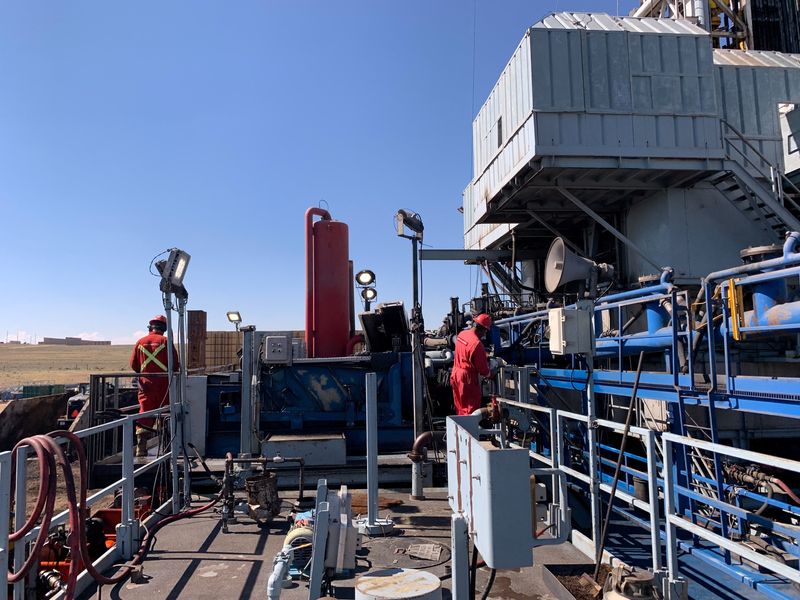(This Nov. 14 story has been officially corrected to fix the quote from Anne Lee Foster in paragraph 17 to clarify that state money used to clean up abandoned wells comes from operators, not taxpayers)
By Liz Hampton
KERSEY, Colo. (Reuters) - Northern Colorado's biggest oil producing region is emerging as a test case for energy companies hoping to tackle the industry's most pressing regulatory and environmental problems: capping old wells that leak climate-warming methane and other emissions.
In this farming community, oil giant Chevron Corp (NYSE:CVX) is sending crews as part of a state-wide push to seal leaks. Once wells are plugged with cement and equipment is removed, workers restore the land to its original state.
Colorado, the fifth largest U.S. oil-producing state, has been in the forefront of anti-drilling sentiment spreading across the country. Voters have set limits to operations near homes and schools, banned routine burning of unwanted gas, and imposed restrictions on fracking chemicals.
Energy companies are being urged to reduce emissions by cities, investors and governments. Federal rules that will require them to monitor and report on climate-warming methane emissions from larger wells are expected early next year.
Last week, U.S. officials pledged to expand those rules to require firms to find and plug leaks from every well no matter how small, and to respond to any complaints of high-volume leaks.
Chevron Corp is running 16 "workover rigs" that do well removal. It plans to deconstruct and plug some 500 old wells in Colorado each year. That work, along with new equipment to clean oil operations, will reduce greenhouse emissions by about 100,000 U.S tons a year, the company said, roughly the same as 21,7000 cars.
Chevron estimates it spends between $80,000 to $100,000 apiece to plug and remove a well and leftover gear.
'EVOLUTION' IN DRILLING
Since 2016, Chevron has removed 3,400 wells in the state and aims to do another 2,200 over the coming years, part of its effort to make oilfields more green. Companies are also employing electric- instead of diesel-powered rigs, eliminating routine flaring and piping production instead of using heavy trucks.
"We've got lower emissions, we have lower ground disturbance. So this is just part of that evolution of what we're doing out here," said Hodge Walker, vice president of Chevron's Rockies Business unit.
Critics say these initiatives are "green-washing" that encourage more fossil fuel production that leads to more emissions.
Plugging old wells could also become big business for energy and service firms given the sheer number of abandoned wells and $1.15 billion in federal funding being made available to states to seal them.
In parts of Ohio, West Virginia, and Pennsylvania, natural gas producer Diversified Energy turned its in-house well-plugging unit into a for-profit business. It also removed some 90 of its own at a cost of about $21,000 each in the first half of 2022. It now aims to cap 200 of its own wells per year.
Such plugging program have comforted investors by addressing wells that could endanger the public and become a liability, said Diversified CEO Rusty Hutson.
But now, he sees a sizeable business from state and federal monies directed to stopping methane leaks. The operation will have 15 rigs and has already won contracts from West Virginia and Ohio to plug orphaned wells that have no identified owners and can leak methane.
Environmentalists say the efforts are overdue.
"We learn to clean up our own messes in kindergarten. This isn't something that deserves applause, it should be expected," said Anne Lee Foster, a Colorado environmental activist.
She initially said Colorado taxpayers have spent about $5 million a year since 2018 to subsidize the cleaning up of abandoned wells, but later revised her statement to clarify the money comes from a fee on oil and gas operators.
RESTORING FARMLAND
On a sunny October day, a Chevron crew in Kersey was mid-way through removing a well drilled in 1992 on 78-year-old Bill Klein's farmland.
The well, called the Patriot 16-12, is a vertical well that pre-dates the shale oil revolution where new drilling techniques helped propel the U.S. into a world-leading oil and gas producer.
"I've never had any problem with the oil companies," says Klein, who for 57 years has owned land around where Patriot 16-12 operated and has collected royalties from oil and gas drilling. He plans to re-farm the land once the wells are safely plugged.

That does not mean the oil industry is walking away from Kersey. Several hundred feet from Chevron's plugging work, PDC Energy (NASDAQ:PDCE) Inc. is drilling a new, horizontal well, which can span over 2 miles underground.
PDC Energy and Chevron regularly share drilling plans to avoid potential collisions that could provide a way for methane to reach the surface.